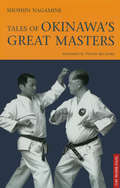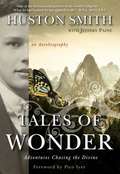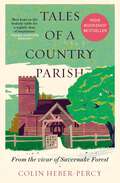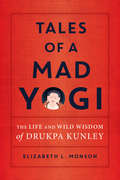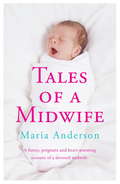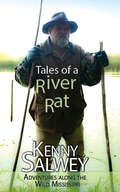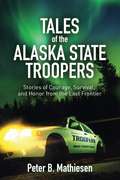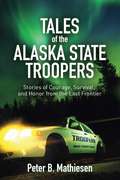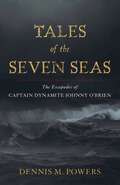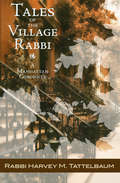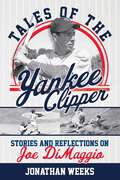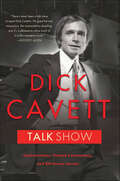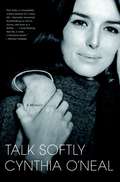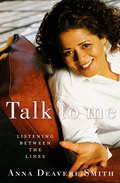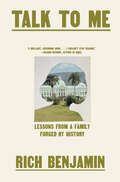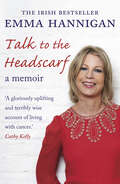- Table View
- List View
Tales of Okinawa's Great Masters
by Shoshin NagamineIn this seminal work, available in English for the first time, a master instructor of Okinawan karate shares the lives and the history of the legendary Okinawan martial arts masters. A must-have for martial arts fans, this classic work includes striking photographs and fascinating anecdotes. 103 photos.
Tales of St. Patrick
by Eileen DunlopFrom the dust jacket: "Not much is known for certain about Patrick, the celebrated patron saint of Ireland. Using Patrick's own writings and other ancient sources, while acknowledging that many of the best-known stories about him are clearly legends, Eileen Dunlop has written about what Patrick's life might have been like. Beginning with his privileged childhood in fifth century Britain, and continuing on through his abduction into slavery in Ireland and his religious awakening, Dunlop paints a portrait of a man who deeply loved God and the Irish people. After many setbacks and years of religious study, Patrick became Bishop of Ireland. He traveled throughout the country and taught Christianity to a largely pagan population. One of the many legends about St. Patrick proclaims that on the night he died, no darkness fell."
Tales of Transformation: A Life in Psychotherapy and Psychoanalysis
by Salman AkhtarOne hundred (and one) tales to mark Salman Akhtar's one hundredth book! Divided into eight informative parts - Dr Akhtar's journey to psychoanalysis; the lessons he learned from his teachers, supervisors, and mentors; the teachings from his peers and colleagues; the benefits of clinical work; the impact of cultural difference; insights gained from students, supervisees, and audiences; his experiences of writing, editing, and publishing; and advice for those about to take their first steps - each section is packed full of incredible advice lightly given in a series of engaging anecdotes. Tales of Transformation: A Life in Psychotherapy and Psychoanalysis is the perfect book for trainees, practising clinicians, those considering psychoanalysis as a career path, anyone with an interest in the subject, and all who enjoy reading the recollections of a witty raconteur.
Tales of Wonder
by Huston SmithHuston Smith, the man who brought the world's religions to the West, was born almost a century ago to missionary parents in China during the perilous rise of the Communist Party. Smith's lifelong spiritual journey brought him face-to-face with many of the people who shaped the twentieth century. His extraordinary travels around the globe have taken him to the world's holiest places, where he has practiced religion with many of the great spiritual leaders of our time. Smith's life is a story of uncanny synchronicity. He was there for pivotal moments in human history such as the founding of the United Nations and the student uprising at Tiananmen Square. As he traveled the world he encountered thinkers who shaped the twentieth century. He interviewed Eleanor Roosevelt on the radio; invited Martin Luther King Jr. to speak at an all-white university before the March on Washington; shared ideas with Thomas Merton on his last plane ride before Merton's death in Bangkok; and was rescued while lost in the Serengeti by Masai warriors who took him to the compound of world-renowned anthropologists Louis and Mary Leaky. In search of intellectual and spiritual treasures, Smith traveled to India to meet with Mother Teresa and befriended the Dalai Lama; he studied Zen at the most challenging monastery in Japan; and he hitchhiked through the desert to meet Aldous Huxley, dropped acid with Timothy Leary, and took peyote with a Native American shaman. He climbed Mount Athos, traipsed through the Holy Land, and was the first to study multiphonic chanting by monks in Tibet, which he recorded with Mickey Hart of the Grateful Dead. Most important, he shared the world's religions with the West-writing two bestselling books and serving as the focus of a five-part PBS television series by Bill Moyers. Huston Smith is a national treasure. His life is an extraordinary adventure, and in his amazing Tales of Wonder, he invites you to come along to explore your own vistas of heart, mind, and soul.
Tales of Wonder
by Huston SmithHuston Smith, the man who brought the world's religions to the West, was born almost a century ago to missionary parents in China during the perilous rise of the Communist Party. Smith's lifelong spiritual journey brought him face-to-face with many of the people who shaped the twentieth century. His extraordinary travels around the globe have taken him to the world's holiest places, where he has practiced religion with many of the great spiritual leaders of our time. Smith's life is a story of uncanny synchronicity. He was there for pivotal moments in human history such as the founding of the United Nations and the student uprising at Tiananmen Square. As he traveled the world he encountered thinkers who shaped the twentieth century. He interviewed Eleanor Roosevelt on the radio; invited Martin Luther King Jr. to speak at an all-white university before the March on Washington; shared ideas with Thomas Merton on his last plane ride before Merton's death in Bangkok; and was rescued while lost in the Serengeti by Masai warriors who took him to the compound of world-renowned anthropologists Louis and Mary Leaky. In search of intellectual and spiritual treasures, Smith traveled to India to meet with Mother Teresa and befriended the Dalai Lama; he studied Zen at the most challenging monastery in Japan; and he hitchhiked through the desert to meet Aldous Huxley, dropped acid with Timothy Leary, and took peyote with a Native American shaman. He climbed Mount Athos, traipsed through the Holy Land, and was the first to study multiphonic chanting by monks in Tibet, which he recorded with Mickey Hart of the Grateful Dead. Most important, he shared the world's religions with the West--writing two bestselling books and serving as the focus of a five-part PBS television series by Bill Moyers. Huston Smith is a national treasure. His life is an extraordinary adventure, and in his amazing Tales of Wonder, he invites you to come along to explore your own vistas of heart, mind, and soul.
Tales of a Country Parish: From the vicar of Savernake Forest
by Colin Heber-Percy'A delightful book from a gentle, generous spirit.' - SIMON RUSSELL BEALE'Philosophical speculation, country lore, rock music, spiritual exploration, erudite and beautifully written, this collection of reflections and meditations is a surprise and a delight. The kind of shot in the arm the Church of England badly needs - and is so rarely to be found.' - SALLEY VICKERSDuring the unprecedented circumstances of Spring 2020, Colin Heber Percy began writing a daily newsletter of reflections and uplifting stories to stay in touch with his parishioners. Word spread, and soon his bulletins were being eagerly consumed by readers around the country and beyond.In this thought-provoking and invigorating book, Heber-Percy draws upon a kaleidoscopic knowledge of nature, philosophy, poetry and music, as well as religious writings, and interlaces them with amusing and touching vignettes from his Wiltshire parish.As he follows the changing seasons, Heber-Percy moves from the seemingly small and mundane to ponder big life questions - can you find heaven in a Londis shop, why is the Bible not like the Highway Code, what on earth we are all doing here - while gently offering up wisdom and sustenance for all, regardless of faith and creed.
Tales of a Country Parish: From the vicar of Savernake Forest
by Colin Heber-Percy'A delightful book from a gentle, generous spirit.' - SIMON RUSSELL BEALE'Philosophical speculation, country lore, rock music, spiritual exploration, erudite and beautifully written, this collection of reflections and meditations is a surprise and a delight. The kind of shot in the arm the Church of England badly needs - and is so rarely to be found.' - SALLEY VICKERSDuring the unprecedented circumstances of Spring 2020, Colin Heber Percy began writing a daily newsletter of reflections and uplifting stories to stay in touch with his parishioners. Word spread, and soon his bulletins were being eagerly consumed by readers around the country and beyond.In this thought-provoking and invigorating book, Heber-Percy draws upon a kaleidoscopic knowledge of nature, philosophy, poetry and music, as well as religious writings, and interlaces them with amusing and touching vignettes from his Wiltshire parish.As he follows the changing seasons, Heber-Percy moves from the seemingly small and mundane to ponder big life questions - can you find heaven in a Londis shop, why is the Bible not like the Highway Code, what on earth we are all doing here - while gently offering up wisdom and sustenance for all, regardless of faith and creed.
Tales of a Female Nomad: Living at Large in the World
by Rita Golden Gelman"I move throughout the world without a plan, guided by instinct, connecting through trust, and constantly watching for serendipitous opportunities." --From the PrefaceTales of a Female Nomad is the story of Rita Golden Gelman, an ordinary woman who is living an extraordinary existence. At the age of forty-eight, on the verge of a divorce, Rita left an elegant life in L.A. to follow her dream of connecting with people in cultures all over the world. In 1986 she sold her possessions and became a nomad, living in a Zapotec village in Mexico, sleeping with sea lions on the Galapagos Islands, and residing everywhere from thatched huts to regal palaces. She has observed orangutans in the rain forest of Borneo, visited trance healers and dens of black magic, and cooked with women on fires all over the world. Rita's example encourages us all to dust off our dreams and rediscover the joy, the exuberance, and the hidden spirit that so many of us bury when we become adults.From the Trade Paperback edition.
Tales of a Mad Yogi: The Life and Wild Wisdom of Drukpa Kunley
by Elizabeth MonsonA fascinating biography of Drukpa Kunley, a Tibetan Buddhist master and crazy yogi.The fifteenth-century Himalayan saint Drukpa Kunley is a beloved figure throughout Tibet, Bhutan, and Nepal, known both for his profound mastery of Buddhist practice as well as his highly unconventional and often humorous behavior. Ever the proverbial trickster and &“crazy wisdom&” yogi, his outward appearance and conduct of carousing, philandering, and breaking social norms is understood to be a means to rouse ordinary people out of habitual ways of thinking and lead them toward spiritual awakening.Elizabeth L. Monson has spent decades traveling throughout the Himalayas, retracing Drukpa Kunley&’s steps and translating his works. In this creative telling, direct translations of his teachings are woven into a life story based on historical accounts, autobiographical sketches, folktales, and first-hand ethnographic research. The result, with flourishes of magical encounters and references to his superhuman capacities, is a poignant narrative of Kunley&’s life, revealing to the reader the quintessential example of the capacity of Buddhism to skillfully bring people to liberation.
Tales of a Midwife
by Maria AndersonMaria Anderson trained as an NHS nurse and went on to become a midwife, a job she has adored for over twenty years. After fainting whilst attending her first three births, Maria went from nervous trainee to assured midwife and in her brilliant memoir she recounts the highs and lows of life inside the maternity unit. From frantic fathers and breaking her hand during a traumatic home birth, to witnessing the delivery of quads and the ultimate devastation of assisting the delivery of a stillborn baby, Maria has had an extraordinary career. Tales of a Midwife is a funny, poignant and heart-warming account of a devoted midwife.
Tales of a Midwife
by Maria AndersonMaria Anderson trained as an NHS nurse and went on to become a midwife, a job she has adored for over twenty years. After fainting whilst attending her first three births, Maria went from nervous trainee to assured midwife and in her brilliant memoir she recounts the highs and lows of life inside the maternity unit. From frantic fathers and breaking her hand during a traumatic home birth, to witnessing the delivery of quads and the ultimate devastation of assisting the delivery of a stillborn baby, Maria has had an extraordinary career. Tales of a Midwife is a funny, poignant and heart-warming account of a devoted midwife.
Tales of a River Rat
by Kenny SalweyThe summer sun hung low over the wooded hills along the Mississippi. I pulled my old straw hat low over my eyes and dozed off. If you could have peered under the mud and the blood and the sweat on my face, you might have seen the corners of my mouth turn up, in the makings of a grin.In Tales of a River Rat, famed storyteller and self-described hermit Kenny Salwey informs and entertains readers as he weaves his life story on the Mississippi River. Salwey knows the river ecosystem with an intimacy unavailable to most. Here he shares his love of and knowledge about the mighty river in an accessible manner sure to appeal to all ages.Kenny Salwey is the last of a breed of men whose lifestyle has all but disappeared in this fast-paced, high-tech digital world. For thirty years, this weathered woodsman eked out a living on the Mississippi River, running a trapline, hiring out as a river guide, digging and selling roots and herbs, and eating the food he hunted and fished. Today, Salwey is a master storyteller, environmental educator, keynote speaker, nature writer, and advocate for the Upper Mississippi River.
Tales of the Alaska State Troopers
by Peter B. MathiesenWith the elements against them, the state troopers of Alaska face every day with a fight for their lives.In the state of Alaska, anything goes. For the state troopers, an average day can include blizzard conditions, midnight sunsets, and subzero temperatures. Tales of the Alaska State Troopers gives insight to just how the brave men and women of the law combat these conditions while still upholding their duties to the fine people of Alaska.Follow trooper Dan Valentine as he finds himself in the midst of a crisis when an abandoned truck holds more than just an old blanket on the passenger seat. Dan's responsibility for the town of Trapper Creek becomes a fight for survival when he realizes the truck has enough explosives in it to make a small dent in the Alaska Range. With his fellow lawmen, Valentine not only must handle the situation, but he must also make sure that the citizens of Trapper Creek are evacuated from harm's way.Tales of the Alaska State Troopers is rich in content and action. Anyone familiar with the life of a lawman or the state of Alaska will be fascinated with the way Mathiesen delivers his narrative. It's all in a day's work for troopers like Dan Valentine, who never know what a new day can bring.
Tales of the Alaska State Troopers: Stories of Courage, Survival, and Honor from the Last Frontier
by Peter B. MathiesenWith the elements against them, the state troopers of Alaska face every day with a fight for their lives. In the state of Alaska, anything goes. For the state troopers, an average day can include blizzard conditions, midnight sunsets, and subzero temperatures. Tales of the Alaska State Troopers gives insight to just how the brave men and women of the law combat these conditions while still upholding their duties to the fine people of Alaska. Follow trooper Dan Valentine as he finds himself in the midst of a crisis when an abandoned truck holds more than just an old blanket on the passenger seat. Dan’s responsibility for the town of Trapper Creek becomes a fight for survival when he realizes the truck has enough explosives in it to make a small dent in the Alaska Range. With his fellow lawmen, Valentine not only must handle the situation, but he must also make sure that the citizens of Trapper Creek are evacuated from harm’s way.Tales of the Alaska State Troopers is rich in content and action. Anyone familiar with the life of a lawman or the state of Alaska will be fascinated with the way Mathiesen delivers his narrative. It’s all in a day’s work for troopers like Dan Valentine, who never know what a new day can bring.
Tales of the Seven Seas: The Escapades of Captain Dynamite Johnny O'Brien
by Dennis M. PowersCaptain Dynamite Johnny O'Brien sailed the seven seas for over sixty years, starting in the late 1860s in India and ending in the early 1930s on the U.S. West Coast. This book tells of sailing over the oceans when danger and adventure coexisted every day, tough times, and courageous men in distant places, from the Hawaiian Islands to the Bering Sea. Smell the salt in the air and hear the ocean's rush as the ship sails with hardened men, leaking seams, and shrieking winds.
Tales of the Towpath: Adventures Along the Lehigh & Delaware Canal
by Dennis SchollTales of the Towpath is a story about growth and change: the industrialization of the United States; a family struggling to prosper in a new land; the maturing of an inquisitive young boy who meets new friends and enjoys exciting adventures that shape his life.
Tales of the Village Rabbi: A Manhattan Chronicle
by Rabbi Harvey M. TattelbaumA warm, witty memoir of Greenwich Village in the late 1950s and &’60s by a young rabbi who led a local synagogue in the midst of it all. In the late fifties and sixties, Greenwich Village was the quirkiest, most charming, jazzy, eccentric, and urban of environments, the center of all that was both quaint and &“cool&”: brownstones and beatniks, coffeehouses and college students, folksingers and freethinkers, poets and &“prophets.&” Into this fascinating mix of cultural archetypes came a young rabbi, Harvey M. Tattelbaum, who became known as the Village Rabbi of the Village Temple. The spirit of Sholom Aleichem infuses his Tales of the Village Rabbi, a touching and laugh‑out‑loud-funny memoir of his tenure at a small synagogue in the heart of Greenwich Village. Though his years in this magical place were productive and soul‑filling, rabbinical training had not exactly prepared him for the bikers, thieves, ex‑cons, eccentric old ladies, drug users, cleavage‑baring brides, and other Village denizens he encountered while serving the congregants of his spirited little temple. Rabbi Tattelbaum shares his insider's tales—both downtown and uptown—of wayward weddings (and funerals), contentious Temple boards, irreverent interfaith shenanigans, heartaches, and triumphs. But the Tales also reveal a deep personal struggle with some of the most profound philosophical problems of ancient and modern religion, and are filled with a warm, humane, and rational approach to spirituality and religious meaning.
Tales of the Yankee Clipper: Stories and Reflections on Joe DiMaggio (Yankees Icon Trilogy)
by Jonathan WeeksThere has probably never been a professional baseball player more of a puzzle than Joe DiMaggio. DiMaggio had a talent for keeping his emotions suppressed and his innermost thoughts to himself. Few could say that they really knew him. And even the ones who did found him to be unpredictable. He was a walking contradiction. He was quiet, but not necessarily shy. He could be both gracious and abrupt, approachable or aloof depending on the situation. Although he came across as humble, he had a tremendous sense of entitlement. He was complex, secretive, inscrutable. There were many layers to the man who came to be affectionately known as the &“Yankee Clipper.&” DiMaggio always felt that his actions on the field should do the talking for him. And for the most part, they did. To many, DiMaggio personified elegance, style, and grace. An impeccable dresser, he was married to two glamorous actresses. On the field, he glided almost effortlessly, never having to dive for a ball and rarely (if ever) making a mistake on the basepaths. He became the living embodiment of the American dream and a symbol of the country&’s so-called &“greatest generation.&” But as time marched on, DiMaggio grew increasingly distrustful of the people around him. It was understandable—inevitable even. The third book in Jonathan Week&’s Yankees trilogy contains an abundance of anecdotes, statistics, and other little known facts about the Yankee Clipper.
Talk Show: Confrontations, Pointed Commentary, and Off-Screen Secrets
by Dick CavettThe legendary talk show host’s humorous reminiscences and pointed commentary on the great figures he has known, and culture and politics today.For years, Dick Cavett played host to the nation’s most famous personalities on his late-night talk show. In this humorous and evocative book, we get to hear Cavett’s best tales, as he recounts great moments with the legendary entertainers who crossed his path and offers his own trenchant commentary on contemporary American culture and politics.Pull up a chair and listen to Cavett’s stories about one-upping Bette Davis, testifying on behalf of John Lennon, confronting Richard Nixon, scheming with John Updike, befriending William F. Buckley, and palling around with Groucho Marx. Sprinkled in are tales of his childhood in Nebraska in the 1940s and 1950s, where he honed his sense of comic timing and his love of magic.Cavett is also a wry cultural observer, looking at America today and pointing out the foibles that we so often fail to notice about ourselves. And don’t even get him started on politicians. A generation of Americans ended their evenings in Dick Cavett’s company; Talk Show is a way to welcome him back.“Do you know that age-old question, If you could have dinner with anyone in the world, living or dead, who would it be? Well, assuming Santa Claus is unavailable, my answer would be Dick Cavett. After reading Talk Show, you could just imagine what a conversation with him would be like: pleasant, insightful, and oddly erotic. Dick Cavett is a legend and an inspiration to me.” —Jimmy Fallon
Talk Softly: A Memoir
by Cynthia O'NealActress and model Cynthia O'Neal was living her dream life--married to the famous stage and screen actor Patrick O'Neal, the mother of two young sons, resident of the Dakota downstairs from John Lennon, owner of the successful Ginger Man restaurant, and frequent guest at dinner parties with Leonard Bernstein and Rudolf Nureyev.And then she changed course suddenly, surprisingly, and completely. The AIDS epidemic hit the arts community hard, and after seeing the multitude of people facing an unfamiliar and stigmatized disease completely alone, Cynthia walked into the fray. With the support of longtime friend Mike Nichols, she founded Friends in Deed and soon found herself spending her days in hospitals, cramped rooms, and dirty apartments, anywhere a patient needed a hug, a hand held, or confidence boosted. And when Patrick became ill and passed away in 1994, Cynthia had to work through her own grief instead of someone else's and found her life transformed again.Talk Softly is the story of a life well-lived--with passion and compassion, in celebration of the joy of each moment, and with the ability to surprise yourself when you least expect to.
Talk of Champions: Stories of the People Who Made Me: A Memoir
by Kenny SmithA revealing, humorous, behind-the-scenes memoir from Kenny "The Jet" Smith—superstar basketball commentator, host of the top-rated show, Inside the NBA, and two-time NBA champion. Smith reveals memorable inside stories of his playing and broadcasting careers, focusing on the star players, coaches, and mentors who inspired him along the way. Kenny Smith was a star at the University of North Carolina before his storied NBA run, in which he won two championships with the Houston Rockets. His popularity skyrocketed when he joined TNT&’s new show, Inside the NBA, which has thrived for twenty-four years and won multiple Emmys, receiving enormous acclaim for the insight, humor, social commentary, and unrivaled basketball coverage from Kenny Smith, Charles Barkley, Shaquille O&’Neal, and Ernie Johnson, Jr. Kenny is known to fans for his laser-sharp analysis and eloquent observations of the basketball scene and culture. In this honest and profound memoir, Kenny writes chapters about each of the extraordinary people who taught him invaluable life lessons. He illuminates the personalities, affections, and quirks of friends such as Michael Jordan, Shaquille O&’Neal, Charles Barkley and Kobe Bryant, among others, and what he learned from each of them. He writes about his legendary UNC coach, Dean Smith, and other indelible role models through his career. And he interweaves poignant material about his upbringing in Queens, New York, his parents, his children, and his marriage, explaining the rich knowledge he obtained from the important figures around him. Kenny is also a strong, intelligent voice on race, as his fans and TV viewers will know. Ultimately this is a revealing, humorous, and powerful memoir, offering a candid glimpse inside the rarified world of elite sports and broadcasting, with inspiring takeaways.
Talk to Me
by Anna Deavere SmithAnna Deavere Smith, the award-winning playwright and actor, has spent a lifetime listening--really listening--to the people around her. As a child in the segregated Baltimore of the early 1960s, Smith absorbed the words of her parents, teachers, neighbors--even train conductors--and realized that there was something more being communicated than the actual words: The conductor's voice had a mild kind of grandeur that was a cousin to the vocal tones I had heard at funerals--"Ashes-to-ashes"--and at christenings and weddings. These are words that have been said many times, but the person who speaks them understands that each time it must be said as if it matters, because it does matter. We never know what lies ahead, and we never know what just happened, and all words must house respect of those two unknowns. In Talk to Me, Smith looks back at a singular career as a seeker and interpreter of language in America, revealing the methodology behind her extraordinary search for the truth and nuances of verbal communication. For thirty years, the defining thesis of Smith's work has been that how we speak is just as important in communicating truth and identity as what we say. Everything from individual vocal tone to grammar, Smith demonstrates, can be as identifiable and revealing as a fingerprint. Her journey has taken her from the rarefied bastions of academia to riot-torn streets; she has conducted hundreds of interviews with subjects ranging from women prisoners to presidents of the United States. In 1995, her ongoing investigation led her to Washington, D. C. After all, what better place to wage an inquiry into the power of language and the language of power than in the city where "message" is a manufactured product? What happens when we as citizens accept--which we seem to be doing more and more--our chosen leaders' failure to tell the truth? And how can we know that we are hearing what Washington really has to say when everything we receive is filtered through the media? Armed with a blazing intellect and a tape recorder, Smith tackled these questions head-on, conducting more than four hundred interviews with people both inside and outside the power structure of Washington. She recorded these sessions in her trademark verbatim transcripts, which include every tic and verbal utterance of her subjects. More than thirty of these remarkable documents appear in this book, including interviews with Bill Clinton, Anita Hill, Studs Terkel, George Bush, Mike McCurry, and Helen Thomas. After five years of searing investigation into the world of the politicians, spin doctors, and power brokers who are steering the course of our country from inside the beltway, Smith has come away with a revelatory assessment--by turns devastating and hopeful--of the lexicon of power and politics in America. Talk to Me is a landmark contribution from a woman whose pioneering insights into language speak volumes.
Talk to Me: Lessons from a Family Forged by History
by Rich BenjaminA piercingly powerful memoir, a grandson&’s account of the coup that ended his grandfather's presidency of Haiti, the secrecy that shrouded that wound within his family, and his urgent efforts to know his mother despite the past.&“A brilliant, absorbing book...I couldn&’t stop reading.&” —Salman Rushdie, author of KnifeRich Benjamin&’s mother, Danielle Fignolé, grew up the eldest in a large family living a comfortable life in Port-au-Prince. Her mother was a schoolteacher, her father a populist hero—a labor leader and politician. The first true champion of the black masses, he eventually became the country&’s president in 1957. But two weeks after his inauguration, that life was shattered. Soldiers took Danielle&’s parents at gunpoint and put them on a plane to New York, a coup hatched by the Eisenhower administration. Danielle and her siblings were kidnapped, and ultimately smuggled out of the country. Growing up, Rich knew little of this. No one in his family spoke of it. He didn&’t know why his mother struggled with emotional connection, why she was so erratic, so quick to anger. And she, in turn, knew so little about him, about the emotional pain he moved through as a child, the physical agony from his blood disease, while coming to terms with his sexuality at the dawn of the AIDS crisis. For all that they could talk about—books, learning, world events—the deepest parts of themselves remained a mystery to one another, a silence that, the older Rich got, the less he could bear. It would take Rich years to piece together the turmoil that carried forward from his grandfather, to his mother, to him, and then to bring that story to light. In Talk to Me, he doesn&’t just paint the portrait of his family, but a bold, pugnacious portrait of America—of the human cost of the country&’s hostilities abroad, the experience of migrants on these shores, and how the indelible ties of family endure through triumph and loss, from generation to generation.
Talk to the Headscarf: Fighting Cancer. Finding Hope.
by Emma HanniganEmma Hannigan was thirty-two and married with two small children when she found out that she had an 85 per cent chance of developing cancer.Over the following year she had a double mastectomy and both ovaries removed, reducing her cancer risk to five per cent.But then her worst fears were realised.Cancer struck anyway.Talk to the Headscarf is the story of how she lived, laughed and overcame some of the toughest times in her life.Emma has now battled cancer eight times. In this inspirational account, she shares with us the highs and lows of her astounding story and shows us that, against the odds, life can and does carry on.
Talk, Talk: A Children's Book Author Speaks to Grown-Ups
by E.L. KonigsburgIn TalkTalk E. L. Konigsburg presents a selection of speeches she has given over a period of 25 years. In her introduction to the first speech, and to the book as a whole, she explains:"While each of my books has been written because I had a story I wanted to tell, these speeches were written because I had something I wanted to say. The audience for the former is children; for the latter, adults.... I recognize -- with a measure of amused detachment -- that some were written as a reaction to trends; others, to fads.I have given these talks in cafetoriums, auditoriums, and the public rooms of Holiday Inns. Even though I have not always been on a stage when addressing an audience, I have tried to set the stage. Between talk and talk, I have written passages connecting the speeches to the time in which they were written and to one another. And that is TalkTalk."Always a thought-provoking speaker, she has chosen nine speeches that capture the essence of her years as a writer for children. When brought together, they enrich one another and provide a chance to look back at what children's books have been, to observe where they are now and to offer an insightful look at what books may continue to mean to children in the years to come. Written by an outstanding author, these speeches, individually and together, represent a vision of the need for books and the role books have played and should continue to play in the lives of children.
